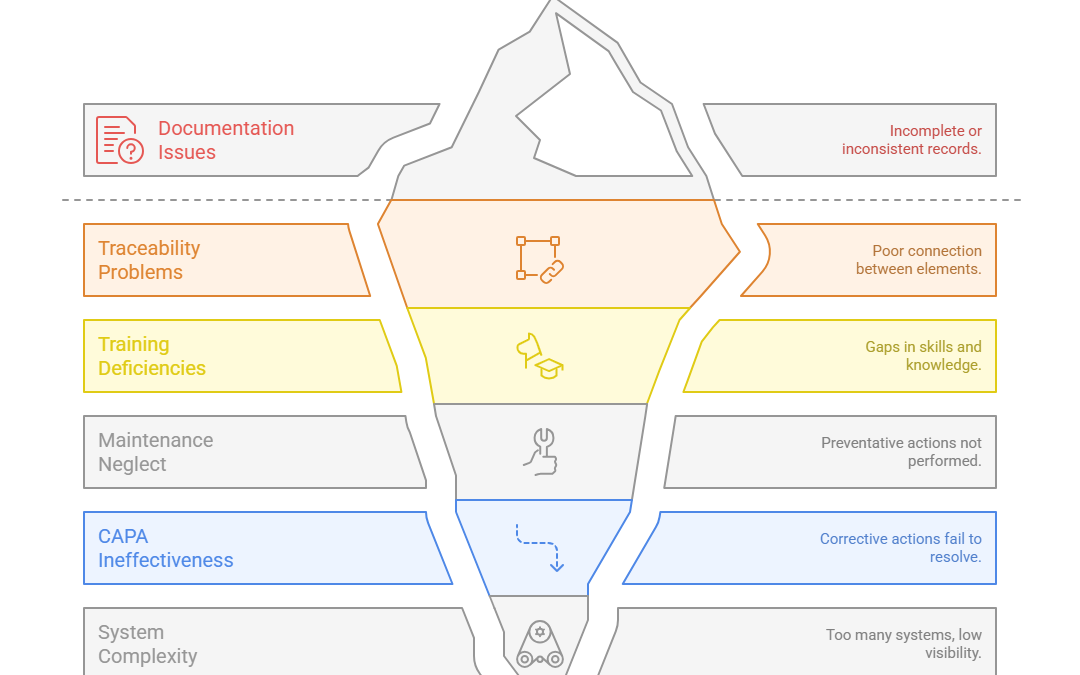Manufacturers operating under NADCAP face unique and intense pressure to maintain precision, traceability, and compliance. When spreadsheets, emails, and siloed systems are still the norm, critical information gets lost, delayed, or misrepresented.
Here are six of the most common challenges NADCAP manufacturers face—and how unifying your systems can solve them while saving time, protecting quality, and ensuring audit readiness.
1. Incomplete or Inconsistent Documentation
Auditors expect every document to be controlled, traceable, and accessible. But when documents are scattered across drives, emails, and paper binders, teams spend hours searching—and still risk using outdated information.
Checklist:
- Procedures stored in multiple locations
- Uncontrolled job travelers and forms
- No clear version control or approval trail
- Gaps in revision history
Takeaway: If you can’t instantly find and prove the current document version was used, you’re out of spec.
Tip: Centralize your document control system with approval workflows and role-based access. Make compliance automatic, not manual.
2. Poor Traceability Between Parts, Processes & People
Whether it’s special processing or final inspections, NADCAP demands traceability across every material, machine, and person involved in the job. Paper logs and disconnected systems make this nearly impossible to maintain consistently.
Checklist:
- Operator sign-offs are inconsistent or missing
- Lot-level traceability stored in spreadsheets
- Difficulty proving which process was used on a specific job
- Nonconformances not tied to job history
Takeaway: Traceability is your best defense in an audit—and your best tool for internal improvement.
Tip: Use digital job travelers that link directly to procedures, qualifications, asset use, and inspection records.
3. Training & Qualifications Tracking Gaps
Can you prove—instantly—that every operator who touched a NADCAP-controlled process was fully qualified and current at the time of work? If you’re managing this with spreadsheets, probably not.
Checklist:
- Training logs updated manually
- Certification expiration dates tracked in Excel
- No system alerts for overdue retraining
- Training not tied to equipment, procedures, or role changes
Takeaway: You don’t just need training—you need proof of readiness, tied to real jobs.
Tip: Use a system that alerts managers to expired qualifications and links personnel status to scheduling and job release.
4. Missed or Undocumented Preventative Maintenance
NADCAP expects reliable preventative maintenance (PM) logs for critical equipment. But many manufacturers still manage PM schedules on whiteboards, spreadsheets, or verbal reminders.
Checklist:
- No automated reminders or work orders
- PM records inconsistent or not linked to jobs
- Hard to prove calibration or maintenance prior to use
- No audit trail for service dates or assigned technicians
Takeaway: Unmaintained tools lead to nonconformances—and audit findings.
Tip: Digitize your PM system. Tie every asset to its maintenance history, responsible owners, and open work orders.
5. CAPAs That Don’t Close the Loop
NADCAP expects more than awareness of problems—they expect documentation, root cause analysis, and proven effectiveness of corrective actions. That’s hard to do when CAPAs are managed over email or in Excel.
Checklist:
- CAPA logs live in isolated folders or spreadsheets
- No structured workflow to ensure follow-up
- Root cause analysis not standardized
- Delays in closure or ownership unclear
Takeaway: If a CAPA isn’t traceable, it doesn’t count.
Tip: Implement a formal CAPA workflow that enforces deadlines, assigns owners, and requires effectiveness checks before closeout.
6. Too Many Systems, Not Enough Visibility
Fragmented systems create more work for every team—and more room for error. With separate tools for document control, training, maintenance, and project tracking, you multiply the chances for misalignment.
Checklist:
- Disconnected systems for every core function
- Manual entry of the same data in multiple places
- Teams working from different versions of the truth
- No single dashboard for audit readiness or performance
Takeaway: Complexity in your tech stack creates complexity in your operations.
Tip: Move to a unified platform like KMDProjects to integrate quality, compliance, asset management, document control, and continuous improvement.
The Bottom Line: Consistency, Traceability, and Compliance Can’t Be Optional
NADCAP doesn’t give partial credit. You either have the evidence—or you don’t. And when that evidence is scattered across tools and teams, your risk increases.
Before KMD:
- Dozens of disconnected spreadsheets and systems
- Manual prep for every audit
- Gaps between process and proof
After KMD:
- One integrated platform for document control, training, maintenance, quality, and compliance
- Audit-ready records at your fingertips
- Cross-functional clarity and continuous improvement
Ready to Build a NADCAP-Ready Operation?
At KMD Technology Solutions, we help manufacturers simplify their operations, eliminate fragmented tools, and confidently pass audits using KMDProjects.
✅ Document Control
✅ Preventative Maintenance
✅ Personnel Qualifications
✅ CAPA Workflow
✅ Asset Traceability
✅ NADCAP Audit Readiness
👉 Request a demo of KMDProjects today and let’s build an operation where quality and compliance are the default—not the exception.
#NADCAP #AuditReadiness #ManufacturingSoftware #ProcessCompliance #QualityManagement #RootCauseAnalysis #PreventativeMaintenance #DocumentControl #KMDProjects #KMDTechnologySolutions


